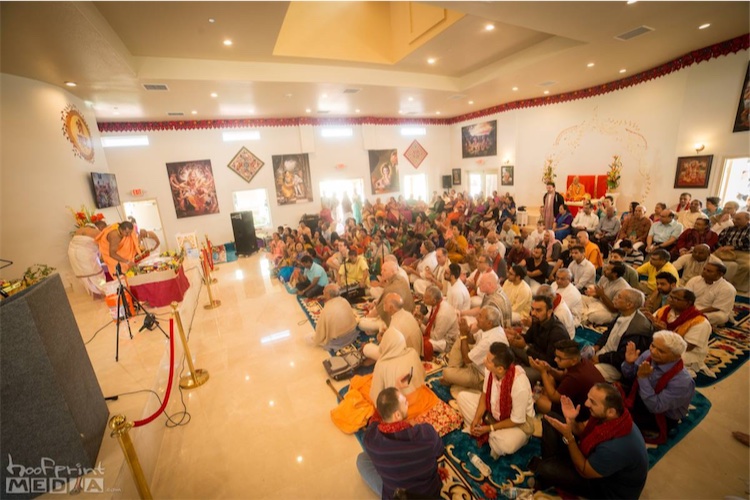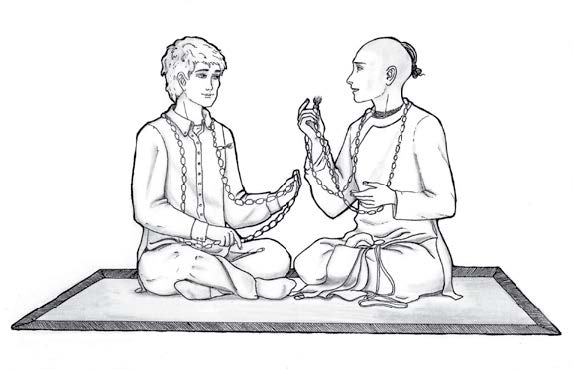What is a Bhakti-vriksha Group?
A Bhakti-vriksha group is a small number of congregational devotees who meet every week to practice Krsna consciousness and to plan preaching activities. In these Bhakti-vriksha groups, the devotees learn how to nourish their spiritual creeper and to cultivate their service attitude in cooperation with others. Every group member is also active in preaching and in bringing new people into the group. Upon reaching fifteen members, the group divides into two. This system keeps the groups small, thus maintaining an intimate atmosphere of personal care and nurturing, which is not possible in large groups. The members help each other under the supervision of a servant-leader and a trainee servant-leader. The trainee servant-leader is being trained and groomed to become the future group leader after the group multiplies into two. Multiplying adds life and increases preaching momentum, compelling new leaders to take initiative. When the group multiplies, the servant-leader continues to supervise one group, while the trainee servant-leader then begins to supervise the other group as a servant-leader. And both of them appoint a new trainee servant-leader.

The meeting has six parts: association, kirtan, japa, discussion, preaching reports and plans, and, finally, prasadam. Bhakti-vriksha groups meet once every week, in the home of one of the members. Even after the weekly get-together, the members act as friends, keep in touch with each other, and participate in outreach programs and preaching excursions.

Although the group leader takes care of all the members, each new member is also individually supervised by a personal guide, someone who has walked a few steps ahead in his spiritual journey. When a new person joins the Bhakti-vriksha group, the group leader assigns the new person to a particular devotee, to offer association and guidance. This system ensures that the advancement and training of the new devotee is closely monitored and helped. Thus deepening his understanding and realisation.

Why is it called “Bhakti-vriksha”?
In Shri Caitanya-caritamrita, Lord Caitanya and His movement are compared to the tree of devotion, the bhakti-vriksha. Srila Prabhupada writes in his summary of chapter nine of Adi-lila:
“It is figuratively described that both the tree itself and the trunk of the tree are Shri Caitanya Mahaprabhu.… The tree surrounds the entire world, and the flowers of the tree are to be distributed to everyone. In this way the tree of Lord Caitanya Mahaprabhu intoxicates the entire world.”
Srila Prabhupada also says,
“Our International Society for Krsna Consciousness is one of the branches of the Caitanya tree.”
(Caitanya-caritamrita, Adi 9.18)
Every small group of ISKCON’s congregation is therefore a branch of the branch, stemming from the bhakti-vriksha (the tree of bhakti) of Lord Caitanya. The Bhakti-vriksha group is a type of Nama-hatta group that is especially geared toward branching out. Just as in a tree, a branch of a certain thickness branches off into two; and the branching process continues until the tree has thousands and thousands of branches, all connected to the main root. Lord Caitanya is the original root, and even one single branch from the Caitanya tree can grow and form thousands of sub-branches, small twigs, leaves, and so on.
We are part of the Caitanya tree. This is the ISKCON branch, and Srila Prabhupada is our connection.
Goal of “Bhakti-vriksha”
The Bhakti-vriksha Program is meant to enable everyone to practice, to grow, and to preach the process of bhakti-yoga. By practicing, the devotee will grow in Krsna consciousness. He or she should also learn how to help others in their Krsna consciousness, so that they will be able to preach to new people. The Bhakti-vriksha Program provides association and spiritual community support, and when the new devotee becomes strong he should preach. One cannot carry out Lord Caitanya’s orders without preaching.
To achieve this in a systematic way requires a great stress on training, on all levels, and on all aspects of practice and preaching. To be successful, the Bhakti-vriksha Program needs to implement a “culture of training.” It is a brahminical, Vaishnava effort, dealing with people’s hearts and minds. It needs ongoing training of every member of every group—by seminars and courses, by practical engagement and philosophical study, by personal development, and by preaching experiences.
On special occasions, such as Gaura-purnima, Janmastami, or Ratha-yatra, all the groups of the city, or sometimes of the whole country, join together for a grand festival.
Larger gatherings provide the joy and inspiration together with hundreds and thousands of friends, an experience not available in the intimate setting of the single group. A devotee needs both. Large public programs also give the opportunity to group members to contact and attract many potential new devotees.
All three experiences of community—in a small group, in a larger gathering, and at a big festival—are essential in the life of the devotee. The small group gives the opportunity to share deeply and intimately with close friends. The weekend Sunday Feast or gathering of the groups provides the chance to enthusiastically celebrate with many devotees.
association is very important. it acts just like a crystal stone, which will reflect anything which is put before it
Nectar of Devotion, Chapter 12,
Srila Prabhupada

Contact Us To Get Connected To A Bhakti Vriksha Group Near Your Area
Follow Us
[social_area][social icon=”facebook” link=”https://en-gb.facebook.com/ISKCON-Reading-1031956553481722″][social icon=”instagram” link=”https://www.instagram.com/iskcon_readinguk/”][social icon=”youtube” link=”https://www.youtube.com/channel/UCq32KOFY-PUT0Rz96KxV5eQ”][/social_area]

